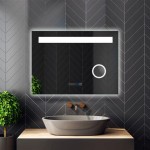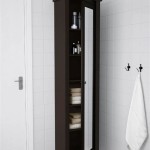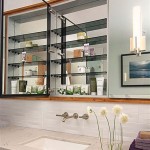Best Practices for Hanging Bathroom Mirrors
Hanging a bathroom mirror might appear to be a straightforward task, but the reality involves careful planning, precise execution, and an understanding of the materials and techniques involved. A poorly hung mirror can be not only aesthetically displeasing but also a safety hazard, potentially leading to damage to the mirror, the wall, or even personal injury. Therefore, a thorough approach is essential, encompassing preparation, installation, and safety considerations.
The selection of the appropriate hanging method depends on several factors, most notably the weight and size of the mirror, the type of wall surface, and the presence of any obstructions behind the wall, such as plumbing or electrical wiring. Failing to account for these variables can result in an unstable installation or even structural damage. This article aims to provide a comprehensive guide to the best practices for hanging bathroom mirrors, covering the necessary steps to ensure a secure and visually appealing result.
Assessing the Mirror and Wall
Before commencing any installation, a detailed assessment of both the mirror and the wall is crucial. This preliminary evaluation will dictate the appropriate hanging method and the necessary tools and materials. The weight and dimensions of the mirror are the primary considerations. Larger and heavier mirrors require more robust support systems than smaller, lighter ones. The mirror’s backing material is also important; some mirrors feature pre-installed hanging hardware, while others require the user to attach their own.
The wall type is equally significant. Bathrooms often feature drywall, which, while common, is not inherently strong enough to support heavy items. In such cases, anchors or wall studs are necessary to provide sufficient support. Tile walls present their own challenges, requiring specialized drill bits and careful drilling techniques to avoid cracking or chipping the tiles. Concrete or brick walls, while structurally strong, necessitate the use of masonry drill bits and appropriate anchors.
Furthermore, it is imperative to check for any hidden obstructions behind the wall. Plumbing pipes and electrical wiring are common in bathrooms, and drilling into either can have serious consequences. A stud finder with an electrical wiring detection feature is a valuable tool for identifying these hazards. If there is any uncertainty about the presence of obstructions, consulting a professional plumber or electrician is strongly advised.
Finally, the desired position of the mirror should be carefully considered. The height and placement should be ergonomically appropriate for the users of the bathroom, and the mirror should be level and centered relative to other fixtures, such as the sink or vanity. Using a laser level or a traditional level in conjunction with a measuring tape will help to ensure accurate placement.
Selecting the Appropriate Hanging Hardware
The selection of appropriate hanging hardware is paramount to the successful and secure installation of a bathroom mirror. The weight and size of the mirror, combined with the type of wall, will dictate the type and quantity of hardware required. A variety of options are available, each with its own strengths and weaknesses.
For mirrors that are relatively lightweight and being hung on drywall, drywall anchors are a common choice. These anchors expand within the wall cavity, providing a secure hold. Toggle bolts are a more robust type of drywall anchor, suitable for heavier mirrors. They consist of a bolt and a spring-loaded wing that expands behind the drywall, distributing the weight over a larger area. Self-drilling drywall anchors are also available, which can be installed without pre-drilling a hole.
If the mirror can be positioned so that its hanging hardware aligns with wall studs, then screws driven directly into the studs provide the most secure support. Wall studs are the vertical framing members within the wall, and they offer a solid anchor point. A stud finder can be used to locate the studs. When using screws, it is important to choose the correct length and type. The screws should be long enough to penetrate the stud by at least one inch, and they should be designed for use with wood.
For tile walls, specialized anchors are required. Tile anchors are designed to grip the tile without cracking or chipping it. These anchors typically require the use of a diamond-tipped drill bit to create a clean hole through the tile. Once the hole is drilled, the anchor is inserted and expanded, providing a secure hold.
Adhesive mounting systems are also available, but these are generally only suitable for very lightweight mirrors. These systems rely on a strong adhesive to bond the mirror to the wall. While convenient, they are not as reliable as mechanical fasteners and may fail over time, especially in humid environments like bathrooms.
In all cases, it is crucial to select hardware that is rated to support the weight of the mirror. Overestimating the required weight capacity is always preferable to underestimating it. It is also important to use high-quality hardware made from durable materials, such as stainless steel or coated steel, to prevent corrosion in the damp bathroom environment.
Executing the Hanging Process
Once the mirror and wall have been assessed and the appropriate hardware has been selected, the actual hanging process can begin. Precision and attention to detail are essential to achieve a secure and visually appealing result.
The first step is to mark the desired location of the mirror on the wall. Use a laser level or a traditional level to ensure that the mirror will be level. Mark the position of the hanging hardware on the wall, using the mirror's mounting points as a guide. Double-check these measurements to ensure accuracy.
If drilling is required, use the appropriate drill bit for the wall type. For drywall, a standard drill bit is usually sufficient. For tile, use a diamond-tipped drill bit and apply gentle pressure to avoid cracking the tile. For concrete or brick, use a masonry drill bit. When drilling, wear safety glasses to protect your eyes from debris.
Once the holes have been drilled, insert the chosen anchors. For drywall anchors, follow the manufacturer's instructions carefully. Toggle bolts require the wings to be folded and inserted into the hole, then allowed to expand behind the wall. For tile anchors, insert the anchor into the hole and tighten it until it grips the tile firmly.
With the anchors in place, attach the mirror to the wall using the appropriate screws or bolts. Tighten the screws or bolts snugly, but do not overtighten them, as this could damage the wall or the mirror. Use a level to ensure that the mirror remains level during the tightening process.
After the mirror is hung, inspect it carefully to ensure that it is secure and stable. Gently push on the mirror to test its stability. If the mirror wobbles or feels loose, re-tighten the screws or bolts, or consider using additional anchors. If the wall surface is damaged, consider using a paintable sealant to fill any gaps around the mirror.
Finally, clean the mirror with a glass cleaner to remove any fingerprints or smudges. Step back and admire your work. A properly hung bathroom mirror can add beauty, functionality, and value to a bathroom.
Following these best practices will ensure a safe, secure, and aesthetically pleasing installation, contributing to the overall functionality and appeal of the bathroom space. Ignoring these guidelines can lead to costly repairs, safety hazards, and a less than satisfactory outcome.

How To Pick And Hang The Perfect Bathroom Mirror Roomhints

Tutorial How To Hang A Bathroom Mirror The Diy Playbook

Guide To Hanging Bathroom Vanity Lighting And Mirrors Liven Design

How To Hang A Wash Basin Mirror Step By Guide Accent

How To Pick And Hang The Perfect Bathroom Mirror Roomhints

How To Hang A Mirror On Window 12 Bright Beautiful Examples Designed

Tutorial How To Hang A Bathroom Mirror The Diy Playbook

How To Install A Mirror Without Frame Merrypad
:strip_icc()/DesireeBurnsInteriors1-f76d25cad90041c88fbae4a7dc10aab4.jpg?strip=all)
2 Simple Ways To Hang A Frameless Mirror

How To Pick And Hang The Perfect Bathroom Mirror Roomhints








